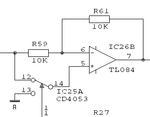frankqt
Member level 4
I like to build a lockin amplifier for an optical application. I currently have a system but the SNR is not enough and based on my research lock in amplifier is the solution. I control both the source (laser) and sink (PD and transimpedance) in my handheld device.
- I will use my processor's clock output (programmable, ARM processor) as the primary clock. The reference frequency is 5MHz (I need a very HF due to nature of my application)
- I have a laser that I will modulate using a Sine Wave (5MHz) (A low pass filter and a current modulator using Opamp) - I can get this working
- I now need to build the receiver. I have already built a standard Transmimpedance amplifier that has a good performance using 400MHz GBW opamps. It is a simple two stage inverting amplifier with a gain of 1M. I like to feed this Opamp output to a circuit along with the 5MHz reference signal and get the output. I am interested in the amplitude of the signal only.
How can I approach to the receiver?
Thanks
- I will use my processor's clock output (programmable, ARM processor) as the primary clock. The reference frequency is 5MHz (I need a very HF due to nature of my application)
- I have a laser that I will modulate using a Sine Wave (5MHz) (A low pass filter and a current modulator using Opamp) - I can get this working
- I now need to build the receiver. I have already built a standard Transmimpedance amplifier that has a good performance using 400MHz GBW opamps. It is a simple two stage inverting amplifier with a gain of 1M. I like to feed this Opamp output to a circuit along with the 5MHz reference signal and get the output. I am interested in the amplitude of the signal only.
How can I approach to the receiver?
Thanks
